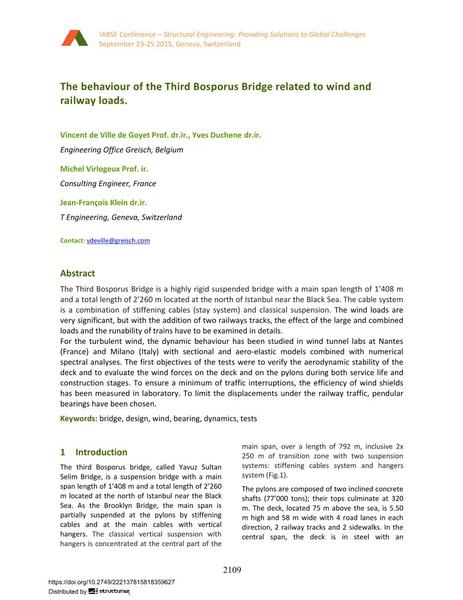The behaviour of the Third Bosporus Bridge related to wind and railway loads

|
|
|||||||||||
Bibliographic Details
| Author(s): |
Vincent de Ville de Goyet
(Engineering Office Greisch, Belgium)
Yves Duchêne (Engineering Office Greisch, Belgium) Michel Virlogeux (Consulting Engineer, France) Jean-François Klein (T Engineering, Geneva, Switzerland) |
||||
|---|---|---|---|---|---|
| Medium: | conference paper | ||||
| Language(s): | English | ||||
| Conference: | IABSE Conference: Structural Engineering: Providing Solutions to Global Challenges, Geneva, Switzerland, September 2015 | ||||
| Published in: | IABSE Conference Geneva 2015 | ||||
|
|||||
| Page(s): | 2109-2116 | ||||
| Total no. of pages: | 8 | ||||
| Year: | 2015 | ||||
| DOI: | 10.2749/222137815818359627 | ||||
| Abstract: |
The Third Bosporus Bridge is a highly rigid suspended bridge with a main span length of 1’408 m and a total length of 2’260 m located at the north of Istanbul near the Black Sea. The cable system is a combination of stiffening cables (stay system) and classical suspension. The wind loads are very significant, but with the addition of two railways tracks, the effect of the large and combined loads and the runability of trains have to be examined in details. For the turbulent wind, the dynamic behaviour has been studied in wind tunnel labs at Nantes (France) and Milano (Italy) with sectional and aero-elastic models combined with numerical spectral analyses. The first objectives of the tests were to verify the aerodynamic stability of the deck and to evaluate the wind forces on the deck and on the pylons during both service life and construction stages. To ensure a minimum of traffic interruptions, the efficiency of wind shields has been measured in laboratory. To limit the displacements under the railway traffic, pendular bearings have been chosen. |
||||
| Keywords: |
design wind bridge bearing tests dynamics
|
||||
